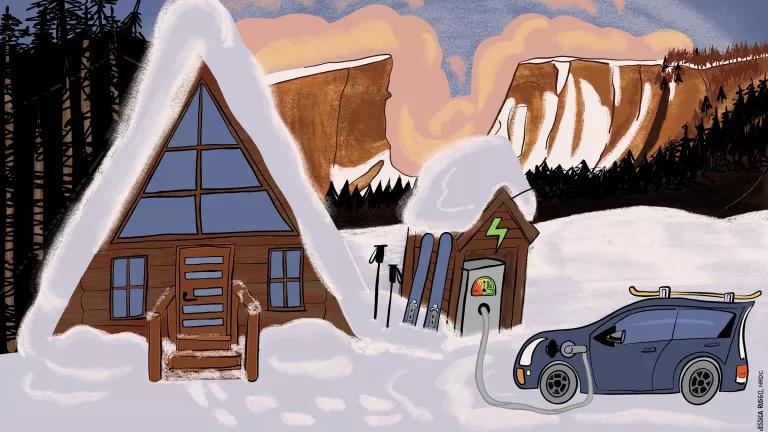California Develops Proposal to Achieve Clean Vehicle Future
California, a global leader in electric vehicle deployment and policy innovation, presented plans today for the next round of its Advanced Clean Cars program. It will require all new vehicles to be electric-drive by 2035.

With transportation now the largest source of carbon pollution in the U.S., the state that created car culture is now driving toward eliminating tailpipe pollution.
California, a global leader in electric vehicle deployment and policy innovation, presented plans today for the next round of its Advanced Clean Cars program. It will require all new vehicles to be electric-drive by 2035. Consistent with the state’s overall climate goals, the proposal would require increased sales of battery electric, fuel cell, or plug-in hybrid electric vehicles to reach 60% of sales by 2030 and 100% of sales by 2035.
California also reaffirmed its commitment to work with the EPA and stakeholders in the development of the next round of a harmonized, federal greenhouse gas emissions program for model years 2027 and beyond. Given the numerous pledges by automakers to transition to electric vehicles, federal policymakers should join with California and set standards that will put our nation on the path to 100% zero-emitting sales by 2035.
After all, California is not alone. More than 100 national, state, and city governments have now committed to 100% emissions-free transport – collectively representing nearly one-fifth of global transport demand.
Why Are Zero-emission Vehicles Needed?
The science is increasingly clear: jurisdictions must rapidly switch to clean, zero-emissions mobility in order to stave off the worst impacts from climate change – including more massive wildfires, intense hurricanes and hotter heat waves. Analysis also shows that to address unhealthy air quality, jurisdictions will also need zero-emission vehicle solutions to reduce smog and toxic air pollution.
It will require historic levels of investments to make the U.S. a leader in EV manufacturing, battery production, and charging station deployment. But the benefits of doing so are immense. Recent analysis by NRDC—together with Shulock Consulting—demonstrated those consumer benefits, public health savings, and climate benefits outweigh the transition costs by nearly seven to one for California. New research by the University of California, Energy Innovation, and GridLab looking at an even more rapid transition across the U.S. found that households would see $2.7 trillion in consumer savings through 2050 (or an average of $1,000 per household every year). These net savings were driven in large part by the enormous fuel savings by switching to electricity.
What Does a Transition to Pollution-Free Cars and Trucks Look Like?
It’s clear that the auto industry is undergoing a historic transition globally to electric vehicles. The main drivers are equal parts technology advancement, competitive pressure, as well as public and government demand for zero-emission mobility in the world’s largest markets including the European Union, China, and the U.S.
Automakers are seeing the writing on the wall and vying to be leaders in the transition or risk having their market share displaced by competitors, including new EV entrants. General Motors set a goal of having 40% of its models be pure EVs by 2025 on the path to going all electric by 2035. Many other automakers are driving in the same direction. All told, 100 pure electric models are expected by the end of 2024, according to Consumer Reports.

A transition in the U.S. would likely follow the path in other jurisdictions with high sales. Norway has already beaten California by over a decade and is now at 75% sale levels of EVs. Sweden, Netherlands, Germany, and France are at 32%, 25%, 14%, and 11% sales respectively compared to California’s current 8% sales level—the highest among all U.S. states. So rapid increases—with the right set of requirements, complementary policies, and market drivers—are possible. Interestingly, the analysis by California Air Resources Board showed that an even higher target—above 60% sales by 2030—is possible if automakers were more aggressive in their rollout schedule of electric-drive models as shown below.
The Plug-In Hybrid Option Remains
While headlines may focus on pure electric drive vehicle like battery electrics, California is allowing for plug-in hybrid electric technologies to continue playing a role in the market. In the fine print, the Air Resources Board did not discount the role of highly-capable plug-in hybrid electric vehicles (think of an even more capable Chevy Volt) that run first in an all-electric mode powered by the electricity grid, followed by switching over to using gasoline as a conventional hybrid. Up to 20% of the new fleet in 2035, based on the requirements, could remain as plug-in hybrid electric vehicles (PHEVs). However, those PHEVs would need to, by 2026, have at least 50 miles of all-electric range will be used after 2025. For most drivers, this all-electric range is sufficient to cover more than 70% of their daily miles. So, while the proposal isn’t doing away with reliance on internal combustion technologies, it gets tantalizingly close to a 100% zero emission future from the tailpipe by 2035.
Leading the Way
Today, there are already 14 states that have adopted all or part of California’s advanced clean cars program, with numerous other states also consider adopting. Today’s proposal provides a model for states wanting to reduce climate pollution, improve public health, and ultimately transportation costs. We’ll be watching whether the automakers that are pledging to transition to an electric fleet and are promising to address climate change are aligning their policy position with their public commitments. We’ll be working to ensure that these electric vehicle goals are not just achieved in the Golden State, but achieved nationally. The clear, open road is before us; let’s move forward!



